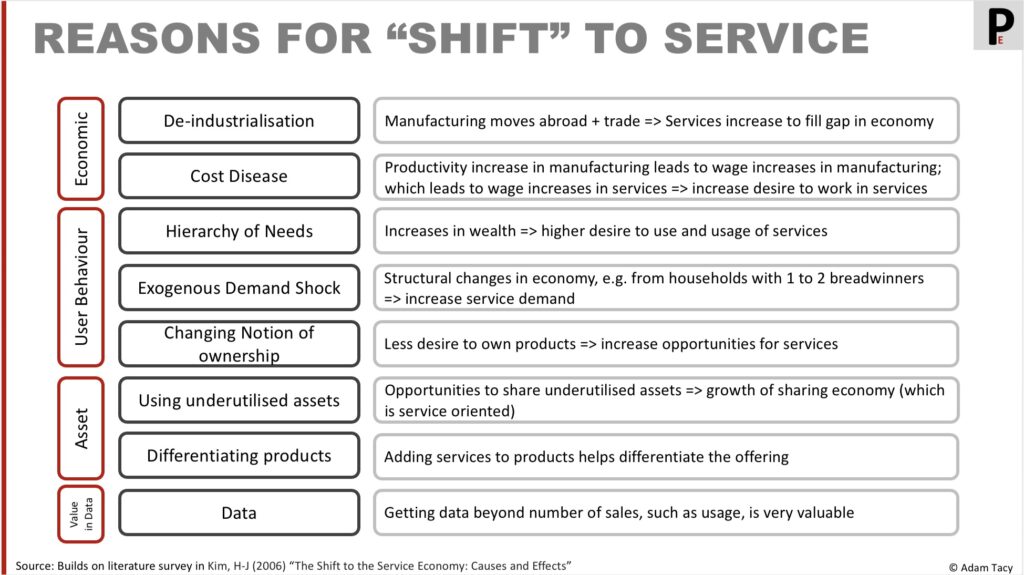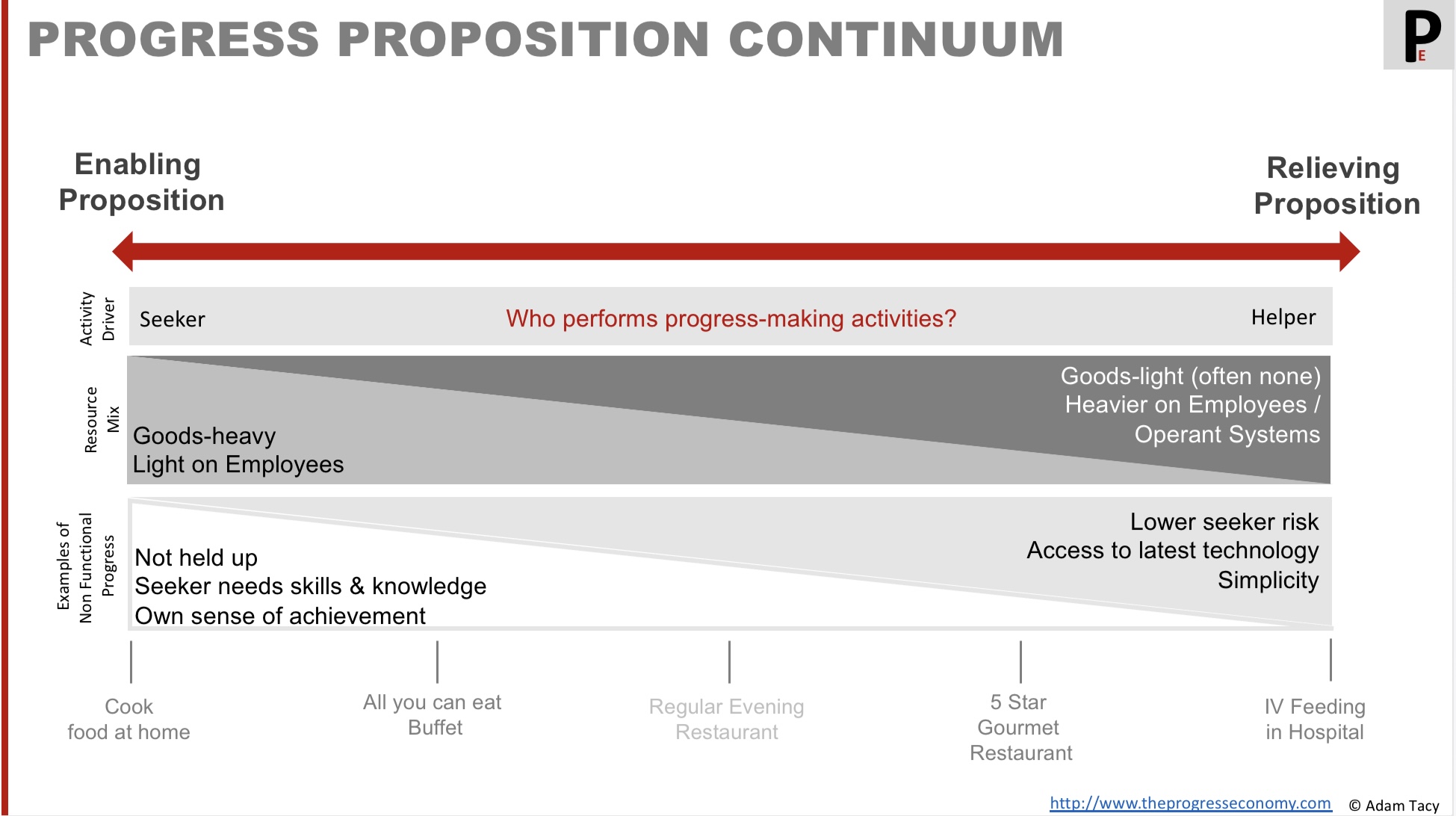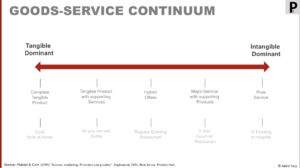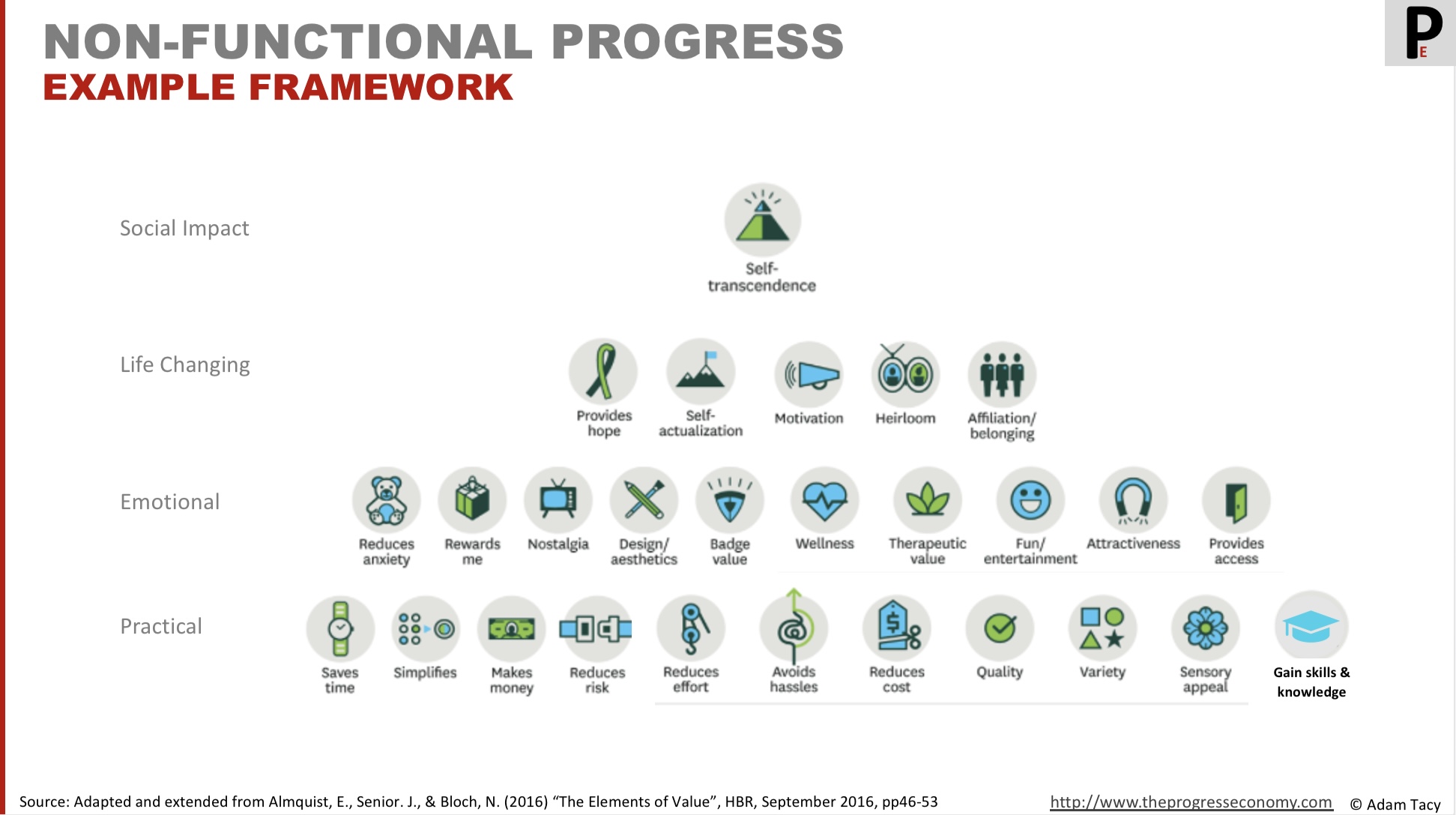What we’re thinking
Every progress proposition sits somewhere on a continuum between enabling progress seekers to attempt progress themselves and relieving them by attempting to make progress for them.
Where a proposition sits is determined by who performs the majority of proposed progress-making activities.
It’s the modern version of the goods-service continuum, fit for the progress economy.
Propositions lie on a continuum between enabling and relieving seekers – giving insights into the progress resource mix and non-functional progress offered; leading to innovation opportunities and impact reasoning. Share on XKnowing where a proposition lies on this continuum gives useful insights into its resource mix composition (employees, goods, systems, etc.), and some aspects of non-functional progress it often facilitates, like self-efficacy or risk aversion.
Moreover, this continuum offers a framework for exploring innovation. Revealing impacts when taking new positions, or seeing new positions when altering the mix or chasing ever evolving progress sought.
A final observation we make is that individual seekers also take positions on the continuum for specific progress attempts. The distance between the seeker’s position and a proposition’s results in a “misalignment on the continuum” progress hurdle.
Helping seekers progress
Before delving into the continuum of progress propositions, let’s explore how propositions help seekers progress. At their core, they are offered to minimise a seeker’s lack of resource progress hurdle, enabling a seeker to reach closer to their progress sought or, at the very least, the progress offered by the proposition.
The three resources that seekers primarily lack are time, skills, and knowledge (the latter two may be encapsulated within themselves, an operant resource, or frozen in goods, an operand resource). Propositions can alleviate a seeker’s lack of resource in two ways: i) by undertaking the progress on their behalf (relieving) or ii) by providing resources that the seeker can utilise.
It might be tempting to attribute the distinction between relieving and enabling proposition solely to the resource of time. The reality is more intricate, involving various non-functional components of a seeker’s progress sought. And exposing some typical components of the resource mix offered.
This is best illustrated with a simple example. Consider the straight forward functional progress of getting nourishment (food). Some generic progress-making activities involve deciding what to eat, purchasing ingredients, preparation, cooking, serving, and finally, eating. Let’s look at how we can relieve and enable the seeker.
Relieving the seeker
Relieving the seeker is likely what most of us think a service does (in our traditional goods-dominant way of thinking). Someone is doing something for us.
And in the progress economy that is reflected in our definition of a relieving proposition. Noting that the progress helper performs the majority (in the extreme case: all) the progress-making activities in a progress attempt.
relieving propositions: propositions where the progress helper performs the majority of the progress making activities
In our example of obtaining nourishment, an extreme relieving proposition would be an IV drip in a hospital. Here, every progress-making activity is carried out by the helper, completely relieving the seeker. Although the seeker still needs a bit of time, as an IV drip is not instantaneous, the time required is less than what would be needed to perform all the activities themselves. The seeker is also freed from the necessity of possessing any skills or knowledge regarding cooking, food preparation, serving, and even eating.
The nature of relieving propositions shapes the resource mix offered by seekers. It predominantly comprises operand resources (resources that act on other resources to make progress) – employees and operand systems. In our nourishment example, we’re referring to nurses and the IV pump.
Such a proposition effectively addresses various non-functional progress components. It simplifies processes, reduces effort, minimises risk and performance anxiety, and potentially instills hope (depending on the underlying need for this extreme proposition). However, it falls short in providing variety, sensory appeal, or fostering a sense of self-actualisation, pride, or prestige.
Enabling the seeker
An enabling proposition is designed to empower a seeker, allowing them to undertake the majority of progress-making activities themselves.
enabling propositions: propositions that enable the progress seeker to perform the majority of the progress making activities
Typically, in an enabling proposition, a helper encapsulates certain skills and knowledge in one or more goods, offering them to the seeker. The seeker then unfreezes those skills and knowledge during acts of resource integration at the time and place they attempt to progress.
However, a key challenge with enabling propositions is that they require the seeker to have the skills and knowledge to use them. That is somewhat supported by the helper providing proposed progress-making activities. For example the joint of meat we are thinking of cooking probably tells us on the packet to cook for 20 minutes per kilo plus 20 minutes at 180C. But those activities may be incomplete. They unlikely says to rub some salt on the meat first, or how much, or what type of oil to use; or which herbs to pair to elevate the taste; or which shelf in the oven is best to use.
More challenges come in that enabling propositions are often limited in scope. For good reason as it makes them usable in many different progress attempts. But it means a seeker needs to know what other propositions they need to chain together to meet their full progress sought. In our getting nourishment example, for instance, we are talking growing ingredients, animal husbandry, cookware, heat sources/stoves, plates, etc (the use of, say, supermarkets involves chaining in a more relieving proposition).
Despite these challenges, enabling propositions support certain non-functional progress sought that relieving ones do not. Such as self-efficacy – the sense of achievement of doing something yourself. And motivation, fun, calming, therapeutic etc. As well as potential to learn new skills and knowledge through attempting. You also don’t get held up, ie waiting for someone else’s resources to become available to you. Whereas they might increase risk and anxiety, don’t simplify, don’t reduce effort, and may not increase quality.
Now we’ve seen the extremes, let’s look at the continuum.
Introducing the Progress proposition Continuum
You are, hopefully, already ahead of me and saying that there are propositions that sit between these extremes. And you’re right. After just a quick think, consider the following relating to our nourishment example:
- Buffet Restaurant: seeker is relieved from preparing and cooking, but they serve themselves and make choices based on the buffet offerings
- Menu-Based Restaurant: seekers are further relieved from serving food and some decisions on what to eat, with choices presented on the menu
- Dining at a Gourmet Restaurant: Seekers simply enjoy the chef’s tasting menu, relieving them from all activities except eating.

I’m sure you can think of more (meal boxes, recipe books, online cooking videos etc).
The key take-away here is as we move down the table, the seeker performs less of the progress-making activities, and the helper performs more. The propositions are sliding from enabling to relieving. This is the progress proposition continuum.
Progress proposition continuum: a continuum between enabling and relieving propositions that reflects how many of the progress-making activities the seeker performs
And we visualise the continuum as the following diagram.

With the bottom half reminding us of the insights we get from the continuum into the progress resource mix and non-functional progress supported.
Let’s discuss the inspiration and evolution of this continuum from traditional goods-dominant world perspective. After that we’ll look at the implications.
Relation to The classic goods-service continuum
Traditionally, our perspective is rooted in goods-dominant logic that sees a world of goods vs service.
However, Palmer & Cole acknowledged that offerings often fall between those two extremes. Leading them to present their well known goods-service continuum (in “Services Marketing: Principles and practice”). That continuum ranges from tangible-dominant offerings (goods) to intangible-dominant ones (services). Highlighting some tangible offerings have supporting service. Whilst some major services have supporting products.
Such a continuum doesn’t make sense in the progress economy, where we remove the goods vs service debate (by noting goods serve as distribution mechanisms for service). We could rename the continuum as the service-service continuum; maintaining the range from tangible-dominant to intangible-dominant. But this doesn’t bring us any new insights.
A more insightful perspective is presented by Vargo & Lush in “Why service?” – where they introduce the concept of direct and indirect service provision. Where service provision can be indirect (ie frozen in a goods) or direct. Vargo & Lush’s ideas hint at a shift from the goods-service continuum to an direct-indirect continuum
Better still, they reference Norman’s work “Reframing business: when the map changes the landscape”. He introduces the concept of enabling and relieving service. To quote from “Why service?”:
Norman’s distinction is essentially based on which party’s operant resources are most central to value creation. In relieving processes, the firm is using its operant resources to provide relatively direct service for the consumer and in enabling processes, the customer is primarily using relatively more of his or her operant resources to act upon resources provided by the firm
Vargo & Lush (2008) “Why service?”
Now we can evolve the goods-service continuum to be an enabling-relieving continuum. Where the position of a proposition on this continuum depends on whose operant resources are primarily used. That is to say, which of the seeker and helper performs the majority of progress-making activities.
Role of the seeker (customer/beneficiary)
Positioning on the progress proposition continuum is then related to whose operant resources are primarily applied to execute progress-making activities.
Early research by Bitner et al (1997) recognised the active roles customers play in service delivery. In “creating service outcomes and ultimately enhancing or detracting from their own satisfaction and the value received”. They identify customers as being a:
Bitner et al (1997) “Customer Contributions and Roles in Service Delivery”
- productive resource;
- contributor to quality, satisfaction and value; and
- competitor to the service organization
This breakdown suggests that customers can be viewed as “partial employees of the service provider” (Bitner et al (1997)) with the provider driving service delivery, and customers sometimes needing to be involved for successful provision.
In the progress economy we actually view this the other way around. The seeker is the primary driver of progress and they may partially of fully employ a helper. But the general point holds, the seeker may be a productive resource in progress attempts. When designing a progress proposition, it’s crucial to understand which progress-making activities the seeker can, and as importantly, wishes to, perform.
While Bitner et al’s second point underscores that involving seekers increases the likelihood of them achieving their desired outcomes. This concept eventually transforms in the literature into the idea general idea of value co-creation within job-to-be-done theories:
the customer is a job (co-)executor who acts in conjunction with the firm to provide service to get a job done
Bettencourt, Vargo & Lush (2014) “A Service lense on Value Creation”
Finally, their point three tells us that a customer may just do things themselves. Therefore becoming a competitor to the helper.
In the context of the continuum, this can be more widely interpreted. Seekers have a wide range of propositions to choose between when attempting progress. Sone will be more relieving and others more enabling than your proposition.
Storbacka and Lehtinen (2001) further elaborate on the role of customers having multiple roles:
a customer (payer), a consumer, a competence provider, a controller of quality, co-producers and/or co-marketers.
Storbacka and Lehtinen (2001) “Customer Relationship Management: Creating Competitive Advantage Through Win-win Relationship Strategies”
Back to Bettencourt, Vargo & Lush (2014), they note:
While the customer always participates in value creation, the customer can have a more or less active role in the service provision itself….
…thus, in matching its resources and capabilities, a company must decide where on a continuum of “enabling” to “relieving” service it will be because this impacts the service role of the customer.”
Bettencourt, Lusch, and Vargo. (2014) “A Service Lens on Value Creation”
It’s not only the role of the seeker that is impacted by where a proposition sits on the continuum. There are a range of implications.
Implications for progress propositions
The position of a proposition on the progress proposition continuum has several implications for it’s design and understanding.
As Bettencourt, Vargo & Lush mention above, it impacts the role of the seeker. Something we’ll look at through the lens of what the seeker needs to bring to the progress attempt.
Beyond that, the position informs the progress resource mix and partly what non-functional progress is reachable. The resource mix is the bundle of resources a helper makes available to a seeker. And non-functional progress is that part of progress sought not related to functionality or context. Think in terms of reduced risk, or self-efficacy.
Lastly, we find a progress hurdle which we call misalignment on proposition continuum. The size of this hurdle reflects the distance on the continuum between a proposition’s and a seeker’s positions. For example, if a seeker is looking for a relieving proposition and your proposition is enabling, the progress hurdle may be high.
Let’s dig into these a little more as they turn out to be important both for adopting propositions and for finding innovation opportunities.
Expectations on seeker
Expectations on seekers vary based on whether the proposition is relieving or enabling. Relieving propositions have lower expectations on seeker knowledge and skills, while enabling propositions demand a higher level of proficiency.
Even the least demanding proposition of either type requires the seeker to define their progress sought. It may seek regular feedback on progress reached during the attempt, with more engaged propositions possibly seeking feedback after completion.
Relieving propositions are well-suited for seekers not inclined, or able, to acquire the resources they lack. These seekers may feel they lack the time, skills, or knowledge to progress, and the helper relieves them of this resource deficiency. However, relieving propositions often come with a higher equitable exchange hurdle, reflecting the increased effort required by the helper. Additionally, they only temporarily alleviate the seeker’s lack of resources.
Contrastingly, enabling propositions expect more from seekers in terms of skills and knowledge. Seekers engaging with enabling propositions need to understand how to use the propositions. They may additionally need to discern the order in which to apply them.
Take a simple example of hanging up a picture. A handyman relieves you the effort here. But doing it yourself requires knowledge of various tools needed especially how to hang items of particular weights on different types of walls.
While enabling propositions often outline detailed progress-making activities, it’s ultimately up to the seeker to follow through. Deviations from the proposed activities – instructions, recipes, manuals etc – likely lead to value co-destruction. Although occasionally this may result in innovative uses.
Composing Resource mixes
A relieving proposition, by definition, relies more heavily on the helper’s operant resources to execute progress-making activities. Consequently, their progress resource mixes is anticipated to be skewed towards operant resources, with employees and certain systems (such as Artificial Intelligence, web browsers, etc.) playing a central role. Though it may certainly include some operand resources.

Whereas the resource mix of an enabling proposition reflects that the seeker’s operant resources are driving the progress-making activities. Therefore it is likely to be heavier on operand types of resources – those that need acting upon for progress to be made. Here we’re thinking goods, locations, and some types of systems (typewriters, dumb call centre routers, etc).
Whereas an enabling proposition indicates the seeker’s operant resources drive the progress-making activities. This suggests the progress resource mix will emphasise operand resources – those that need to be acted upon for progress to occur. These include goods, locations, and certain systems (like typewriters, basic call center routers, etc.).
Offering physical resources – goods where access is only temporary – moves us slightly along the continuum, but can still be thought of as enabling so long the seeker drives the activities. Hiring a tool you use is enabling; using a train is generally not (unless for some reason you become the driver).
Offering non-functional progress
Enabling propositions are particularly suited to seekers who want to minimise being held-up making progress (an aspect of non-functional progress).
Often the seeker acquires ownership of the operant resources offered by the helper with the first engagement. Subsequently they can use any non-consumed resource again whenever and wherever they want. Once you have a hammer you can hammer whenever and whatever you want. Unfortunately, if its a consumable, say ingredients in our running example, then once used they are gone.
However, it’s worth noting that when a resource is not in use, it is not helping anyone progress (co-create value). So enabling propositions are often inefficient in resource usage. Leading to the innovation opportunity of how can they be made more efficient?
We can use our adaption of Almquist et als attributes of value to find non-functional progress aspects propositions support.
For example, enabling propositions support the satisfaction of making progress yourself (self-efficacy/actualisation). As well as “rewards me” and “fun/exciting” and perhaps “therapeutic” and “badge value” (your friends being impressed with your cooking). They can also “reduce cost”
Relieving propositions support reaching a different range of non-functional progress. A key one is reducing risk. Since the helper drives the progress-making activities the risk of failing the attempt is on them (or so the seeker is likely to believe). They also support saving time, simplifying, reducing effort, often increasing quality and so on. But doesn’t reduce cost (equitable exchange) or help gain skills and knowledge.
Moreover, by using relieving propositions, seekers can gain access to the latest approaches and technologies. In a subscription service for tools, a seeker should expect technology refreshes in the offering.
revealing a progress hurdle
Finally we find the continuum reveals a progress hurdle to us. Bettencourt, Vargo & Lush tell us in their 2014 paper “A Service Lens on Value Creation“:
…a company must decide where on a continuum of “enabling” to “relieving” service it will be because this impacts the service role of the customer.”
Bettencourt, Lusch, and Vargo. (2014) “A Service Lens on Value Creation”
However it’s not just propositions that sit on the progress proposition continuum. We find individual seekers also take a position for specific progress attempts at specific times.
They might look for a more relieving proposition at one point in time and a more relieving proposition at another point. Often driven by lack of resource (time, skills etc) and non-functional progress sought (for example self-efficacy or risk reduction).
The distance between where your proposition sits on the continuum and where the seeker does manifests as one of six progress hurdles, in this case the misalignment on continuum progress hurdle.
Relating to innovation
The great thing about the continuum is it provides an excellent framework for innovation, allowing progress helpers to explore new positions, adapt their service mix, understand shifting seeker positions, and identify supplementary propositions. This dynamic approach enables progress helpers to continually refine and enhance their offerings to better meet the evolving needs of progress seekers.
Exploring New Positions
By navigating along the continuum, progress helpers can explore new positions that cater to the evolving needs and preferences of progress seekers.
Why not explore the impacts of moving towards a relieving service – applying AI or servitisation/platform asa service? Or moving the other way to attract seekers looking to learn new skills.
These fresh positions often lead to innovative propositions that better align with the changing landscape of progress.
Adapting the resource Mix
The ability to update the resource mix is a key feature of the continuum. Progress helpers can assess and modify the mix of resources and activities offered to align more closely with the specific requirements of progress seekers.
This adaptability ensures that propositions remain relevant and effective in achieving progress.
Understanding Shifting Seeker Positions
Progress seekers may shift their positions on the continuum over time. We currently see a general gravitation towards relieving propositions (called “shift to the service economy” in goods-dominant logic). Helpers can better reason about this on the continuum. As well as understand why there may be a useful opportunity of seekers going the other way.

Identifying Supplementary Propositions
Helpers can introduce supplementary propositions that help narrow the misalignment hurdle. Whether acting as the incumbent helper or a challenger/complementer, they can refine their offerings to reduce the gap between their propositions and progress seekers’ needs.
As an illustrative example of the last point, consider the “cooking yourself” proposition. If a seeker lacks cooking skills and knowledge, the progress helper can enhance the service mix by including resources such as cookbooks, online instructional videos, physical or online cook-along sessions, and on-demand assistance. This comprehensive approach not only addresses the seeker’s skill gap but also offers a more holistic solution for achieving progress.





